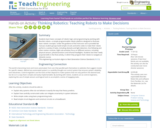
Play a game of concentration by matching terms used in the scientific method to their proper description.
- Subject:
- Mathematics
- Science
- Material Type:
- Game
- Provider:
- IXL
- Date Added:
- 12/01/2023

Play a game of concentration by matching terms used in the scientific method to their proper description.

This site provides a good explanation of deductive and inductive thinking.

Students learn how two LEGO MINDSTORMS(TM) NXT intelligent bricks can be programmed so that one can remotely control the other. They learn about the components and functionality in the (provided) controller and receiver programs. When its buttons are pressed, the NXT brick assigned as the remote control device uses the controller program to send Bluetooth® messages. When the NXT taskbot/brick assigned as the receiver receives certain Bluetooth messages, it moves, as specified by the receiver program. Students examine how the programs and devices work in tandem, gaining skills as they play "robot soccer." As the concluding activity in this unit, this activity provides a deeper dimension of understanding programming logic compared to previous activities in this unit and introduces the relatively new and growing concept of wireless communication. A PowerPoint® presentation, pre/post quizzes and a worksheet are provided.

Do you know how to get to Sesame Street? This collection is designed to engage preschoolers in everyday learning by teaching core skills in Math, Literacy, STEM, and Social and Emotional Development. Here you'll find hundreds of videos, games, and printable materials to help you to excite even the youngest learners.

In this video, meet Rio, a captive California sea lion who has helped research biologists to better understand the cognitive abilities of this species. See how Rio has learned that certain sounds are associated with certain letters or numbers, and observe how she demonstrates the higher order reasoning skill of logic. Biologist Colleen Reichmuth explains how Rio has learned that all letters can be grouped together and is able to use a logic rule to solve a new problem. Consider how this reasoning ability is related to language. [4:42]

Students learn basic concepts of robotic logic and programming by working with Boe-Bot robotsâa simple programmable robotic platform designed to illustrate basic robotic concepts. Under the guidance of the instructor and a provided lab manual, student groups build simple circuits and write codes to make their robots perform a variety of tasks, including obstacle and light detection, line following and other motion routines. Eight sub-activities focus on different sensors, including physical sensors, phototransistors and infrared headlights. Students test their newly acquired skills in the final activity, in which they program their robots to navigate an obstacle course.

After viewing video components, students use manipulatives to work with the famous Towers of Hanoi problem. The goal is for learners to begin to understand recursive logic and thinking, relevant to computer scientists, mathematicians, and engineers.

This free encyclopedia site from Wikipedia gives a definition and examples of deductive reasoning. It also has links to related terms and topics.

Student teams act as engineers and learn about systems thinking and scale by reassembling the separated pages of the engaging picture book, “Zoom,” by Istvan Banyai. The book is a series of 31 wordless pictures that start very close-up and then zoom out—from a rooster’s comb to outer space. Like a movie camera, each subsequent page pulls back to reveal the context of the previous scene as something different than what you originally thought. When the 31 un-numbered pages are jumbled, it is a surprising challenge for teams to figure out how the pictures connect. The task prompts students to pause and look closer so as to adjust to new points of view and problem solve to find a logical sequence. It requires them to step back and take a broader view. Students learn that engineers work together as teams and look at things very closely so that they see different things and come up with more than one solution when problem solving. To conclude, students go outside and practice their skills by imagining and then drawing their own Zoom-like small booklet stories inspired by items found in nature. The classic duck/rabbit ambiguous drawing is provided as a kickoff visual aid.